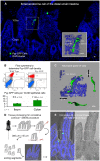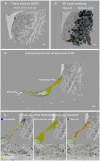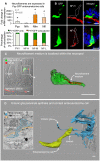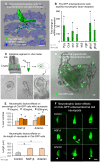An enteroendocrine cell-enteric glia connection revealed by 3D electron microscopy
- PMID: 24587096
- PMCID: PMC3935946
- DOI: 10.1371/journal.pone.0089881
An enteroendocrine cell-enteric glia connection revealed by 3D electron microscopy
Abstract
The enteroendocrine cell is the cornerstone of gastrointestinal chemosensation. In the intestine and colon, this cell is stimulated by nutrients, tastants that elicit the perception of flavor, and bacterial by-products; and in response, the cell secretes hormones like cholecystokinin and peptide YY--both potent regulators of appetite. The development of transgenic mice with enteroendocrine cells expressing green fluorescent protein has allowed for the elucidation of the apical nutrient sensing mechanisms of the cell. However, the basal secretory aspects of the enteroendocrine cell remain largely unexplored, particularly because a complete account of the enteroendocrine cell ultrastructure does not exist. Today, the fine ultrastructure of a specific cell can be revealed in the third dimension thanks to the invention of serial block face scanning electron microscopy (SBEM). Here, we bridged confocal microscopy with SBEM to identify the enteroendocrine cell of the mouse and study its ultrastructure in the third dimension. The results demonstrated that 73.5% of the peptide-secreting vesicles in the enteroendocrine cell are contained within an axon-like basal process. We called this process a neuropod. This neuropod contains neurofilaments, which are typical structural proteins of axons. Surprisingly, the SBEM data also demonstrated that the enteroendocrine cell neuropod is escorted by enteric glia--the cells that nurture enteric neurons. We extended these structural findings into an in vitro intestinal organoid system, in which the addition of glial derived neurotrophic factors enhanced the development of neuropods in enteroendocrine cells. These findings open a new avenue of exploration in gastrointestinal chemosensation by unveiling an unforeseen physical relationship between enteric glia and enteroendocrine cells.
Conflict of interest statement
Figures





Similar articles
-
Correlative Confocal and 3D Electron Microscopy of a Specific Sensory Cell.J Vis Exp. 2015 Jul 19;(101):e52918. doi: 10.3791/52918. J Vis Exp. 2015. PMID: 26273796 Free PMC article.
-
Neuroepithelial circuit formed by innervation of sensory enteroendocrine cells.J Clin Invest. 2015 Feb;125(2):782-6. doi: 10.1172/JCI78361. Epub 2015 Jan 2. J Clin Invest. 2015. PMID: 25555217 Free PMC article.
-
GPR41/FFAR3 and GPR43/FFAR2 as cosensors for short-chain fatty acids in enteroendocrine cells vs FFAR3 in enteric neurons and FFAR2 in enteric leukocytes.Endocrinology. 2013 Oct;154(10):3552-64. doi: 10.1210/en.2013-1142. Epub 2013 Jul 24. Endocrinology. 2013. PMID: 23885020
-
Serial block face scanning electron microscopy in cell biology: Applications and technology.Tissue Cell. 2019 Apr;57:111-122. doi: 10.1016/j.tice.2018.08.011. Epub 2018 Sep 3. Tissue Cell. 2019. PMID: 30220487 Review.
-
Neuropods.Cell Mol Gastroenterol Hepatol. 2019;7(4):739-747. doi: 10.1016/j.jcmgh.2019.01.006. Epub 2019 Jan 30. Cell Mol Gastroenterol Hepatol. 2019. PMID: 30710726 Free PMC article. Review.
Cited by
-
Cannabinoids Block Fat-induced Incretin Release via CB1-dependent and CB1-independent Pathways in Intestinal Epithelium.Gastro Hep Adv. 2024 Jul 22;3(7):931-941. doi: 10.1016/j.gastha.2024.07.006. eCollection 2024. Gastro Hep Adv. 2024. PMID: 39318720 Free PMC article.
-
Gastrointestinal Vagal Afferents and Food Intake: Relevance of Circadian Rhythms.Nutrients. 2021 Mar 5;13(3):844. doi: 10.3390/nu13030844. Nutrients. 2021. PMID: 33807524 Free PMC article. Review.
-
Identification of intestinal and fecal microbial biomarkers using a porcine social stress model.Front Microbiol. 2023 Nov 9;14:1197371. doi: 10.3389/fmicb.2023.1197371. eCollection 2023. Front Microbiol. 2023. PMID: 38029169 Free PMC article.
-
Guanylyl cyclase C ameliorates visceral pain: an unsuspected link.J Clin Invest. 2023 Feb 15;133(4):e166703. doi: 10.1172/JCI166703. J Clin Invest. 2023. PMID: 36787251 Free PMC article.
-
Interactions Between Commensal Bacteria and Enteric Neurons, via FPR1 Induction of ROS, Increase Gastrointestinal Motility in Mice.Gastroenterology. 2019 Jul;157(1):179-192.e2. doi: 10.1053/j.gastro.2019.03.045. Epub 2019 Mar 28. Gastroenterology. 2019. PMID: 30930024 Free PMC article.
References
-
- Wang J, Cortina G, Wu SV, Tran R, Cho JH, et al. (2006) Mutant neurogenin-3 in congenital malabsorptive diarrhea. N Engl J Med 355: 270–280. - PubMed
-
- le Roux CW, Batterham RL, Aylwin SJ, Patterson M, Borg CM, et al. (2006) Attenuated peptide YY release in obese subjects is associated with reduced satiety. Endocrinology 147: 3–8. - PubMed
Publication types
MeSH terms
Grants and funding
LinkOut - more resources
Full Text Sources
Other Literature Sources
Molecular Biology Databases

